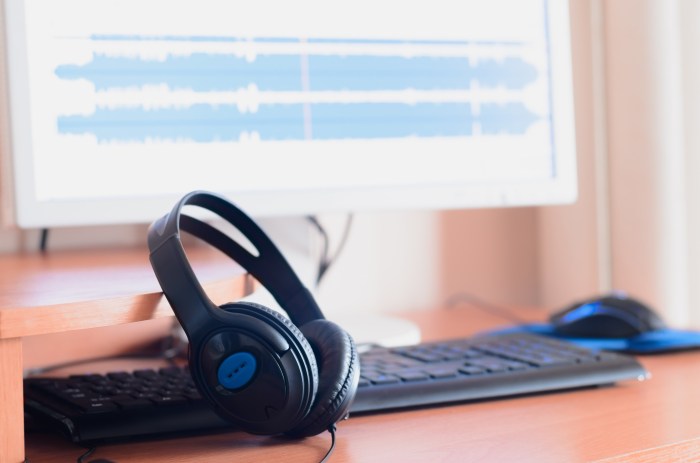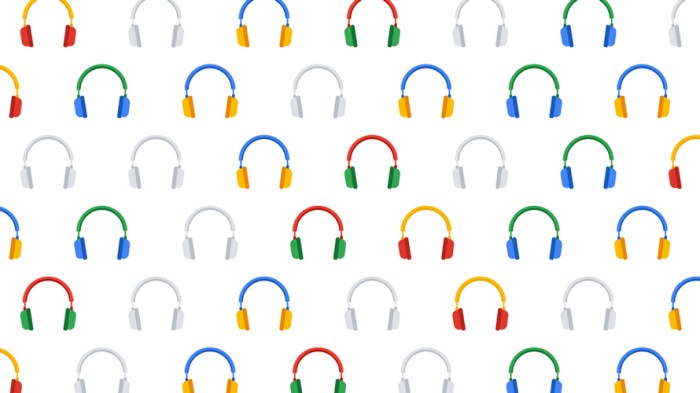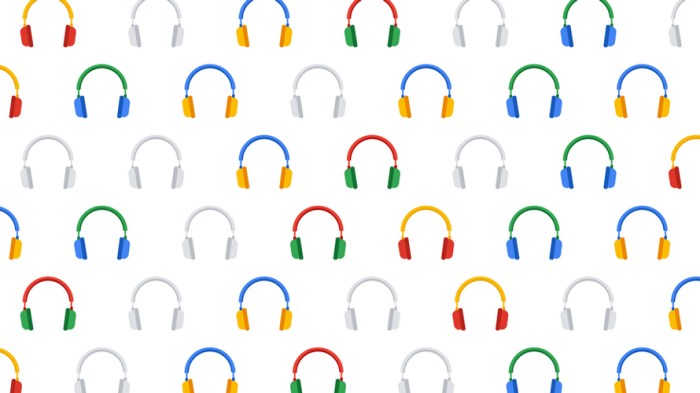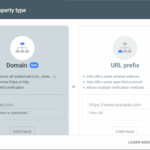Google makes audio ads available to all advertisers, opening a new frontier for brands looking to connect with audiences in a dynamic and engaging way. This move signals a significant shift in the digital advertising landscape, allowing businesses of all sizes to leverage the power of audio to reach potential customers in a unique manner. The introduction of audio ads offers a compelling alternative to traditional visual formats, providing new opportunities for creativity and interaction.
This expanded accessibility promises a surge in innovative audio ad campaigns. From tailored messaging to enhanced targeting, advertisers can now connect with their target audience on a deeper level. Expect to see a wealth of creative audio ad formats emerge, capitalizing on the growing popularity of podcasts and audio streaming services. This shift in advertising strategy will undoubtedly reshape how brands engage with their audience, making audio a key element in their marketing mix.
Overview of Google’s Audio Ad Initiative

Google’s recent decision to open audio advertising to all advertisers marks a significant shift in the digital advertising landscape. This move signifies a recognition of the growing importance of audio content consumption and a strategic effort to expand its advertising revenue streams. The company anticipates this will provide new opportunities for businesses to reach audiences in a more engaging and targeted way.This initiative reflects Google’s ongoing commitment to providing comprehensive advertising solutions.
The availability of audio ads broadens the options for advertisers, allowing them to tap into a wider range of user engagement methods. This strategy suggests that Google recognizes the potential for significant growth in this market segment.
Key Benefits for Advertisers
The key advantages Google highlights for advertisers using audio ads include increased reach and engagement, a more targeted approach, and cost-effectiveness. Advertisers can now reach audiences passively listening to podcasts, audiobooks, or music, potentially expanding their customer base. This method allows for highly specific targeting based on user listening habits, potentially leading to a higher conversion rate. Additionally, audio ads often come with lower costs compared to other formats, making them a more accessible option for small and medium-sized businesses.
Google’s move to make audio ads available to all advertisers is a big deal. It opens up a whole new world of possibilities for reaching potential customers. To make the most of this opportunity, focusing on effective Twitter engagement is key. Check out these 5 tools to increase twitter engagement overnight 5 tools to increase twitter engagement overnight to really boost your campaigns.
Ultimately, understanding the power of audio advertising, combined with strong social media engagement, is crucial in today’s market.
Potential Impact on the Digital Advertising Landscape
The introduction of audio ads will likely reshape the digital advertising landscape by creating a new avenue for brand exposure. This will encourage increased competition among advertisers, potentially driving innovation in audio ad creation and targeting strategies. The development of sophisticated audio ad formats, similar to the evolution of video ads, is a strong possibility. Furthermore, it could lead to the creation of new audio-centric platforms and businesses that specialize in audio advertising services.
Comparison of Audio Ads with Other Google Ad Formats
| Ad Format | Description | Targeting Options | Cost Structure | Strengths | Weaknesses |
|---|---|---|---|---|---|
| Text Ads | Simple, concise text ads displayed on search results pages. | -based targeting. | Typically CPC (cost per click). | High visibility, quick to implement. | Limited space for branding, less engaging. |
| Display Ads | Visual ads that appear on websites and apps. | Demographic, interest-based targeting. | Typically CPM (cost per mille, or thousand impressions). | Visually appealing, brand building potential. | Can be intrusive, user may ignore. |
| Video Ads | Animated or filmed advertisements. | Demographic, interest-based, and behavioral targeting. | CPM, CPC, or other models. | Highly engaging, powerful storytelling potential. | Requires production cost, longer load time. |
| Audio Ads | Sound-based ads played within audio platforms. | Interest-based, listening habits, and demographic targeting. | Typically CPM or CPC, potentially more affordable. | Highly engaging, can reach a passive audience. | Less visual impact, reliance on audio quality. |
This table highlights the key distinctions between various Google ad formats. It emphasizes the diverse targeting options, cost structures, and potential strengths and weaknesses associated with each format. This comparison demonstrates the increasing diversity of advertising avenues offered by Google.
Target Audience and Reach
Audio ads represent a compelling new frontier for advertisers, offering a unique opportunity to connect with audiences in a more engaging and immersive way. Leveraging the power of sound, these ads can transcend the limitations of traditional visual formats and resonate with listeners on a deeper level. The potential for reaching a wide range of demographics and interests makes audio advertising a valuable tool for businesses of all sizes.The ability to tailor audio ads to specific demographics and interests opens up a world of possibilities for advertisers.
From highly targeted campaigns to broad-reach awareness initiatives, audio ads offer a flexible approach that can be adapted to suit diverse marketing goals. Location-based targeting adds another layer of precision, allowing advertisers to pinpoint specific geographic areas and reach listeners with relevant messages.
Potential Target Audiences
Audio ads can effectively target a wide spectrum of demographics and interests. Listeners actively engaged with audio content often have specific hobbies, professional fields, or lifestyle choices that advertisers can capitalize on. This includes individuals who listen to podcasts in specific niches, attend particular events, or frequent specific online communities. By understanding the content consumed and the listener’s context, businesses can craft ads that resonate with their interests.
Examples include podcasts dedicated to finance, health, or technology, which allow for targeted ads to listeners with an interest in those areas.
Google’s latest move to open audio ads to all advertisers is a big deal. It opens up a whole new world of possibilities for businesses to reach their target audience. This new accessibility also highlights the importance of a well-designed website, and a custom 404 page WordPress plugin can help immensely. By providing a seamless user experience, even when a page isn’t found, you’ll keep visitors engaged, improving overall website performance and driving conversions – a vital aspect of successful audio advertising campaigns.
So, with audio ads now more accessible, you need to be ready for those potential clicks!
Broader Reach of Audio Ads
Audio ads offer a broader reach compared to other ad formats, particularly in scenarios where visual distractions are present or when users prefer a less obtrusive form of advertising. While video ads can be impactful, they often require more attention and time for consumption. Audio ads, by their nature, can be absorbed in the background, fitting seamlessly into a listener’s routine.
This allows advertisers to reach a larger audience without disrupting the user experience, which is a key differentiator. For instance, commuters listening to audiobooks or podcasts are exposed to audio ads without losing their focus on the primary content.
Tailoring Audio Ads to Specific Demographics
Advertisers can tailor audio ads to specific demographics by employing various strategies. These strategies involve careful selection of podcast topics, music genres, and voiceovers that resonate with the target audience. For example, an ad for a fitness app might feature a dynamic and energetic voiceover in a podcast focusing on health and wellness. Similarly, an ad for a financial institution could use a calming and authoritative tone in a podcast discussing personal finance.
These nuances are crucial in establishing a strong connection with the target demographic.
Leveraging Location Data for Enhanced Targeting
Location data plays a significant role in enhancing the effectiveness of audio ad targeting. This allows for precise targeting based on listener location. By knowing the listener’s location, advertisers can deliver relevant ads to listeners in specific geographic areas. This precision ensures that ads are seen only by those who are likely to be receptive to the message.
Google opening up audio ads to everyone is a game-changer. It’s a huge opportunity for businesses to reach new audiences, but how can you use this to actually steal your competition’s followers? Strategies to snag those coveted followers are key, and now with audio ads, you can really target your ideal customer on a deeper level.
Ultimately, the ability to utilize audio ads effectively will determine your success in this new market.
Imagine a local restaurant broadcasting an audio ad targeted at people in a particular neighborhood, thereby reaching a high-potential customer base.
Targeting Options for Audio Ads
| Targeting Option | Description | Example |
|---|---|---|
| Podcast Category | Targeting listeners based on the podcast genre they are consuming. | Targeting listeners of a finance podcast with an ad for a financial planning service. |
| Demographic Data | Targeting based on age, gender, and other demographic information. | Targeting women aged 25-45 with an ad for a beauty product. |
| Interest-Based Targeting | Targeting listeners based on their expressed interests, such as hobbies or professions. | Targeting listeners interested in technology with an ad for a new gadget. |
| Location-Based Targeting | Targeting listeners based on their current location. | Targeting listeners in a specific city with an ad for a local restaurant. |
Creative Considerations for Audio Ads
Audio ads are no longer a niche marketing strategy; they’re becoming a powerful tool for reaching audiences in diverse ways. As Google opens its audio ad platform to all advertisers, understanding the nuances of effective audio campaigns is crucial. This includes crafting compelling scripts, utilizing sound design, and incorporating clear calls to action. This guide will help you navigate these aspects, ensuring your audio ads resonate with listeners and drive conversions.
Best Practices for Effective Audio Ad Campaigns
Effective audio ads go beyond simply broadcasting a message. They require careful planning and execution to capture attention and achieve desired outcomes. Best practices involve meticulous script writing, compelling sound design, and strategically placed calls to action. A well-structured campaign considers the target audience, the overall marketing objectives, and the platform’s capabilities.
Importance of Compelling Audio Scripts and Sound Design, Google makes audio ads available to all advertisers
A strong audio script is the cornerstone of a successful audio ad. It needs to be concise, engaging, and memorable. Sound design, including music, sound effects, and voice acting, enhances the impact of the script and helps create an immersive listening experience. The right music or sound effects can elevate the emotional response to your message, ensuring your ad cuts through the noise.
Strategies for Incorporating Strong Calls to Action Within Audio Ads
Clear and concise calls to action are essential in audio ads, as listeners may not have the opportunity to immediately interact. The call to action should be stated clearly, preferably within the initial 30 seconds of the ad, and ideally accompanied by a memorable tag line. Use a unique phrase, an easily-remembered number, or a specific website address to make the call to action stand out.
Examples of Successful Audio Ad Campaigns from Different Industries
Several successful audio ad campaigns demonstrate the power of the medium. For instance, a fitness brand might use upbeat music and motivational voices to encourage listeners to start a workout routine. A tech company could use sound effects and clear explanations to highlight the features of a new product. These examples show how the creative approach can significantly influence listener engagement.
Different Audio Formats Supported for Audio Ads and Their Usage
Google’s audio ad platform likely supports various formats, including MP3, WAV, and potentially other compressed audio formats. Different formats may be suitable for different scenarios. For instance, a short, catchy jingle might be best suited for an MP3 format. Conversely, a detailed explanation or narration could benefit from a higher-quality WAV file.
Tips for Writing Scripts for Various Ad Types
Crafting effective scripts for different ad types requires adapting the approach to the specific objective. Here are some tips:
- Informative Ads: Provide concise and factual information about the product or service. Highlight key benefits and features, but avoid overly technical jargon.
- Promotional Ads: Offer limited-time discounts or promotions to encourage immediate action. Use clear and persuasive language, emphasizing the value proposition of the offer.
- Brand Awareness Ads: Focus on building brand recognition through memorable jingles or slogans. The aim is to leave a lasting impression on the listener.
Metrics and Measurement

Figuring out if your audio ads are working is crucial. Knowing what metrics to track and how to interpret them allows you to optimize your campaigns for better results. Understanding the effectiveness of audio ads is no different than understanding the effectiveness of any other advertising medium; it’s about measuring the right things.A key aspect of successful audio advertising lies in the ability to meticulously track and analyze performance.
This involves not only identifying the appropriate key performance indicators (KPIs) but also selecting the right tools and platforms for accurate measurement. This detailed approach ensures you can understand what resonates with your target audience and fine-tune your strategy for maximum impact.
Key Performance Indicators (KPIs) for Audio Ads
Understanding the performance of audio ads requires a clear set of KPIs. These indicators provide a framework for evaluating the effectiveness of your campaigns, allowing you to make data-driven decisions. These metrics go beyond simple impressions and clicks, delving into engagement and conversions.
- Reach and Frequency: These metrics quantify how many unique listeners heard your ad and how often they were exposed to it. High reach signifies broad audience exposure, while frequency helps determine optimal repetition for maximum impact. For instance, a high frequency of exposure might indicate an audience interested in your product or service, while low frequency might suggest needing to adjust the campaign targeting or messaging.
- Listenership Metrics: These metrics focus on audience engagement with your audio ads. They include metrics like completion rate (percentage of listeners who heard the entire ad), average listening time, and the number of listeners who interacted with the ad (e.g., visiting your website or making a purchase).
- Call to Action (CTA) Performance: Measuring how effective your audio ads are at driving desired actions is essential. This includes tracking metrics like website clicks, app downloads, or phone calls generated directly from the ads.
- Conversion Rates: This metric measures the percentage of listeners who completed a desired action after hearing your ad. This could be a purchase, a sign-up, or another action that directly relates to your business goals.
- Return on Ad Spend (ROAS): ROAS provides a clear picture of the financial return you’re getting from your audio ad investment. By tracking the revenue generated relative to the cost of the ad, you can determine the profitability of your campaigns.
Tracking and Analyzing Audio Ad Performance
Effective tracking and analysis are critical to optimize audio ad campaigns. Using the appropriate tools and platforms is vital for a comprehensive understanding of campaign performance.
- Google Ads Platform: The Google Ads platform offers robust tools for tracking and analyzing audio ad performance, providing insights into metrics such as impressions, clicks, and conversions. It also allows for A/B testing different ad creatives and targeting options to identify what resonates best with your audience.
- Third-party Analytics Tools: Tools like Nielsen Audio, and other specialized audio analytics platforms can provide deeper insights into listener demographics, listening habits, and ad recall. These platforms are often more advanced in terms of data analysis and provide more granular data for a deeper understanding of your audience.
- Data Reporting: Regularly reviewing and analyzing your data is crucial. This involves identifying trends, patterns, and areas for improvement in your audio ad campaigns. Tools can generate reports that visualize key metrics, allowing for a clear overview of campaign performance. These reports should be tailored to your specific business goals, highlighting metrics that directly impact your desired outcomes.
Comparison of Audio Ad Performance Metrics
The following table provides a comparison of various audio ad performance metrics, highlighting their importance and how they contribute to overall campaign success.
| Metric | Description | Importance |
|---|---|---|
| Reach | Number of unique listeners exposed to the ad. | Indicates the breadth of audience exposure. |
| Frequency | Number of times each listener was exposed to the ad. | Indicates the level of ad repetition. |
| Completion Rate | Percentage of listeners who heard the entire ad. | Measures listener engagement and ad effectiveness. |
| Average Listening Time | Average duration of time listeners spent engaged with the ad. | Indicates audience engagement and interest in the ad content. |
| Click-Through Rate (CTR) | Percentage of listeners who clicked on a CTA. | Indicates effectiveness of CTA in driving desired actions. |
| Conversion Rate | Percentage of listeners who completed a desired action. | Measures the ultimate impact of the ad on achieving business objectives. |
Potential Challenges and Opportunities
Audio ads, while promising, present unique challenges and opportunities for advertisers. Navigating the nuances of the listening experience and effectively integrating audio into the user journey requires a thoughtful approach. The cost-effectiveness and potential for brand building are significant advantages, but these must be weighed against the challenges of capturing attention in a predominantly auditory environment.
Potential Challenges for Advertisers
Advertisers need to be mindful of potential pitfalls when incorporating audio ads into their campaigns. The lack of visual cues can make it harder to convey complex messages or product details. Listeners may be less attentive than viewers, requiring more concise and engaging audio content. The prevalence of background noise and interruptions can also impact ad recall and effectiveness.
Moreover, measuring the impact of audio ads, while improving, can still lag behind visual metrics.
Enhancing User Experience with Audio Ads
Audio ads can greatly enhance the user experience when integrated seamlessly. They can provide valuable information or entertainment without disrupting the user’s primary task. For example, an audio ad about a new workout routine could play while a user is exercising, providing motivation or guidance. The key is to avoid intrusive or distracting experiences.
Seamless Integration into the User Journey
Audio ads should feel natural and unobtrusive, fitting into the context of the user’s activity. For instance, an audio ad for a local coffee shop could play while a user is listening to a podcast about cafes. This context-awareness improves the relevance and receptiveness of the ad. Consider using interactive elements, such as a call to action, within the audio ad to encourage user engagement.
Cost-Effectiveness Compared to Other Ad Formats
Audio ads generally offer a more cost-effective way to reach a large audience compared to some other formats. This cost-effectiveness is due to the lower production costs of audio compared to video, and the potential for targeted audio ad campaigns to reach specific listeners. Furthermore, audio ads can be used in various environments like podcasts, audiobooks, or streaming services, opening avenues for wider reach.
This cost-effectiveness is particularly appealing for small businesses and startups.
Building Brand Awareness through Audio Ads
Audio ads are an excellent tool for building brand awareness and creating memorable experiences. By creating unique and consistent audio branding, advertisers can enhance brand recall and recognition. This includes using specific sound effects, music, or voiceovers that are easily associated with the brand. For example, a consistent jingle in an audio ad can create instant brand recognition.
Furthermore, by associating the audio with positive experiences or engaging narratives, advertisers can build a stronger connection with the audience.
Future Trends and Predictions: Google Makes Audio Ads Available To All Advertisers
The democratization of audio advertising through Google’s initiative opens exciting possibilities for the future. As more advertisers embrace this medium, the market will likely evolve, adapting to the unique characteristics of audio and the ever-changing consumer landscape. This section explores potential future trends, including format innovations, technological advancements, and how these developments might impact pricing strategies.The audio advertising landscape is poised for significant growth.
This growth is not simply an expansion of the existing market but a transformation driven by new opportunities and challenges. The integration of audio into existing advertising strategies will be crucial for success.
Future Audio Ad Formats
The rise of interactive audio experiences will redefine how audiences engage with advertisements. Expect to see more dynamic formats that integrate sound design, music, and even interactive elements. This could involve clickable sound effects or audio prompts that lead users to additional information or calls to action. For example, a podcast advertisement might incorporate sound effects that trigger a listener to visit a website or download an app.
Personalized audio ads tailored to individual user preferences will likely become more sophisticated. These ads could use information gleaned from user listening habits and browsing history to deliver highly targeted and relevant audio experiences.
Impact of New Technologies
Artificial intelligence (AI) will play a significant role in optimizing audio ad campaigns. AI can analyze listening data to determine optimal ad placement, timing, and targeting. This personalization will be a key factor in ensuring higher engagement rates and better return on investment (ROI) for advertisers. Machine learning algorithms can also be used to generate personalized audio ad copy, adjusting language and tone based on the specific audience being targeted.
This ensures higher relevance and improved ad effectiveness.
Innovative Use Cases
Audio advertising is not confined to simple announcements. Creative applications are already emerging, like using ambient sound in public spaces to deliver targeted ads to pedestrians. Imagine a shopping mall playing a subtle audio jingle that promotes a particular store. This type of contextual advertising can provide an immersive and memorable brand experience. Another example is the integration of interactive audio experiences within video games.
Brands could leverage sound effects and ambient audio to subtly promote their products, enhancing player engagement without disrupting the gaming experience.
Pricing Strategy Implications
The wider availability of audio ads will potentially influence pricing strategies. Competition will likely increase as more advertisers enter the market, which could lead to a more dynamic pricing model. Advertisers might opt for pay-per-listen or pay-per-action models, rather than just pay-per-impression, depending on the desired outcomes and target audience. The specific metrics used for pricing will be critical in ensuring a fair and effective market for both advertisers and listeners.
End of Discussion
Google’s decision to open up audio ads to all advertisers represents a significant advancement in the digital advertising sphere. The accessibility and potential for tailored campaigns offer substantial opportunities for businesses to connect with their target audience in a new, more immersive way. This new frontier in audio advertising is poised to revolutionize how brands communicate with consumers, and the future looks bright for innovative and effective audio ad campaigns.
From creative considerations to measurement and future trends, the potential is vast and compelling.






